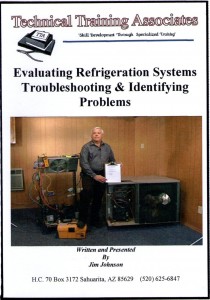Refrigeration systems operating at a higher-than-normal discharge pressure can be the result of several different issues. Depending on the degree of increase, the system could be operating inefficiently or not at all, and it could damage the compressor.
One common cause of high discharge pressure is the cooling medium (air or water) flowing across the condenser: either there is not enough or the temperature of the cooling medium is too high. This is normally easy to identify with a simple visual inspection of the condenser.
Another common cause is a fouled (dirty) condenser, which will prevent the refrigerant from effectively rejecting its heat content. This will cause an increase in the discharge pressure, as well as causing the temperature of the liquid refrigerant leaving the condenser to be higher than normal. If the condenser’s subcooling value were measured, it would appear to be within a normal operating range because of the increase in both the refrigerant’s pressure and temperature.
Another possible cause is an excessive amount of refrigerant in the system, commonly referred to as an overcharge. This will cause the excess liquid refrigerant to take up condensing space, which will cause less space to condense the refrigerant, leading to an elevated discharge pressure. However, in this scenario, the temperature of the refrigerant leaving the condenser may be only slightly above the ambient temperature, which would cause the condenser’s subcooling to be higher than normal.
A less common cause is noncondensables trapped in the condenser. The noncondensables will take up space in the condenser, leaving less room for the condensing of the refrigerant. There will be a greater difference between high condensing temperature and liquid leaving the condenser, so its subcooling value will appear to be higher than normal.
Identifying which of these issues is causing the elevated discharge pressure is usually straightforward but can be a little tricky at times. To start, determine if the system has been serviced recently. If the system has been working fine for years and no one has serviced it before the technician arrived, it is unlikely that the cause is noncondensables or an overcharge. Instead, it is likely an issue with the cooling medium or a fouled (dirty) condenser. On air-cooled condensers, a good visual inspection should help identify this cause. However, sometimes the coil may not appear to be that dirty on its surface, but it may be dirty between the fins. When in doubt, simply cleaning the condenser will help eliminate this possible cause.
On water-cooled condensers, it may be harder to identify a fouled coil, since a visual inspection is not always possible. Measuring the condenser subcooling value will help to identify this problem. If the condenser’s subcooling value appears to be within its normal range but both the pressure and temperature are elevated, it is likely a dirty coil or an issue with the cooling medium.
If the system has been serviced previously, ask if refrigerant has been added to the system. If the condenser’s subcooling value appears to be high and refrigerant was recently added to the system, then the problem could be either noncondensables or an overcharge. The more common of the two is an overcharge of refrigerant, and recovering some of the refrigerant will help to rectify this problem.
If it is suspected that noncondensables are trapped in the system, then the following procedure can be used to test an air-cooled condenser:
- Determine the type of refrigerant in the system.
- Electrically disable the compressor and allow the condenser fan to operate.
- Attach a temperature probe to both the discharge line and liquid line.
- Place a third temperature probe to measure the temperature of the air entering the condenser.
- Connect a pressure gauge on the system to measure the pressure of the refrigerant in the condenser.
- When all three temperature probes (discharge line, liquid line, and air entering the condenser) are at the same temperature, record the pressure of the refrigerant in the condenser.
- Using a P/T (pressure/temperature) chart, convert the measured pressure to its saturation temperature. The converted temperature should be within a few degrees of the measured discharge, liquid, and air entering temperatures.
- If the converted temperature is higher than the measured temperatures by more than a few degrees, there are noncondensables in the system that need to be removed.
Lastly, do not overlook the obvious. I had a friend struggle with trying to identify the cause of a system operating with high discharge pressures. Turns out, his gauge was faulty and there was no issue with the system. It did take another technician to discover this problem, but it was a great lesson for all of us. Always check your tools.
See more articles from this issue here!








